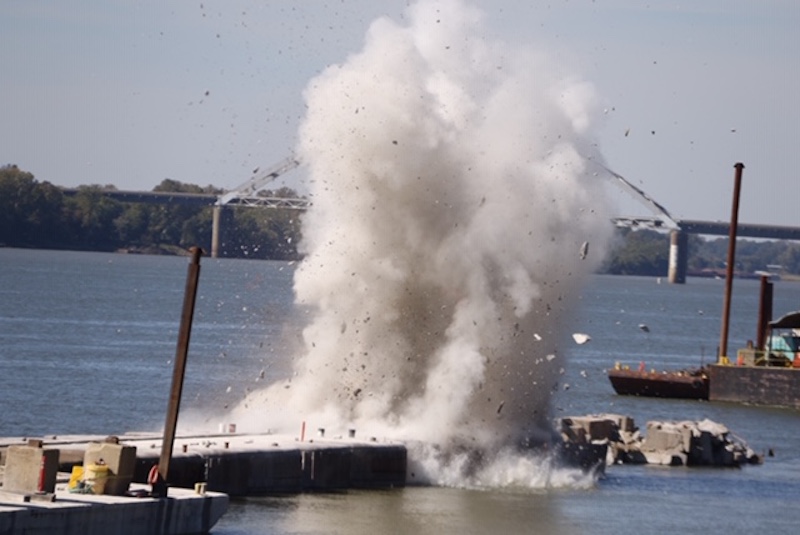High water conditions continue to hamper progress to dismantle the old locks and dams that have been replaced by the Olmsted project along the Ohio River in Illinois, while also causing restrictions on tows that are using the nation’s newest, most advanced and expensive civil works project.
The U.S. Army Corps of Engineers and their contractors have stopped work on removing Lock and Dams 52 and 53, and will resume once the river levels drop, possibly not until June or July, according to Katelyn Newton, spokeswoman for the Corps’ Louisville District.
On Feb. 15, the Corps required all tows passing through Olmsted to have a minimum of 240 hp per barge and also imposed restrictions on the number and size of barges, citing high flow conditions. This continues restrictions that were in effect during Olmsted’s construction, but the number fluctuated seasonally depending on water conditions.
Demolition of Lock and Dam 52, located at Brookport, Ill, is scheduled for completion in December this year, and is about 25% complete. Progress has been slow as work that was supposed to start last May didn’t get underway until the end of July, due to persistent high water last spring and summer.
The first phase of demolition of Lock and Dam 53, located near Grand Chain, Ill, included removal of the wickets, miter gates, culvert valves, mechanical piping and electrical components, is about 65% finished. Removal of the fixed weir and beartraps on the Kentucky bank is scheduled to be awarded in late spring, with completion in late 2021, she said.
“The longer high water periods and shorter low water seasons have been the principal delays to date,” Newton said. “The high water only allowed about four months of work in 2019, compared to the expected six months.”
Both structures are more than 90 years old and each included the original 600-foot original lock and a 1,200-foot lock added in 1969 that was supposed to be temporary. Due to the age and small size of the infrastructure, there were frequent delays and bottlenecks for inland barges moving commodities through this important and busy confluence of the Mississippi and Ohio rivers, as barges were required to break apart and lock in two sections.
Resuming work has been hampered by high river flows this winter. For work to resume on 52, river elevation must be at 307 feet, which is the top of the lock walls. At 53, it can go once the river level reaches 310 feet elevation or lower. This can typically be expected to occur in the June-July timeframe, she said, “but if the river drops to those levels sooner, hopefully work can begin before then.”
That may be optimistic, however. The National Weather Service said last week that current wet soil and rain conditions in the Midwest could cause spring flooding this year along the Mississippi River similar to what occurred in 2019. And in late January the Corps reported that water flows on the Upper Mississippi were already at levels normally observed in late spring. Irregular temperatures have prevented ice from forming in a stable way, which compounds the ice dam problem, the agency said in a statement. Ice has blocked the river’s normal flow, forcing water out of its banks and hampering the Corps’ ability to actively manage the river water elevations.
“We have never in our record had these sustained high flows over the month of January,” Dan Fasching, St. Paul District water manager for the Upper Mississippi, said in a statement, adding that depending on temperatures and the rate of ice melt there could be more high water in the months ahead.
Demolition of locks 52 and 53 that has been done so far has had little impact on barge traffic, Newton said. On 52, “other than 2-3 hour traffic stops on days when the constraints is performing blasts, there has been no effect on navigation and none is expected. The contract requires the contractor to to maintain an 800-foot-wide navigation channel.”
At 53, the only impact was during removal of wickets, which has been completed. She expects some minor disruptions with phase two during disposal of debris in the designated areas, “but it should be minimal.”
Removal of both structures is the final step in completing the historic Olmsted Lock and Dam project, which has been in the works for more than 30 years and cost far more than projected, due to engineering changes and funding hiccups. It opened to much fanfare in August 2018 as the nation’s most innovative and costly civil works project, clocking in at $3.5 billion.
The Corps has not yet amassed hard data on barge movements and improved efficiencies compared to the old locks and dams, but Newton said barges are seeing smoother and more efficient operations through this part of the inland system. Olmsted is equipped with twin 1,200-foot locks, which eliminates the need to break up tows as was done when 52 and 53 were in operation.
“In the last few years that 52 and 53 were operational, there were several more occasions of pool drawdown and lock chamber closures which resulted in significant delays to navigation traffic,” she said. “In Olmsted’s first full year of operation, there was clearly improved efficiency with keeping navigation traffic moving with minimal delays.”
The industry agrees, although persistent high water has been a challenge for barging.
“We’ve certainly seen improved reliability, but not yet at 100 percent capacity as we have been limited in the size of tows across the pass,” said Mark Knoy, president and CEO of American Commercial Barge Line. “I do believe these restrictions will be lifted sometime this year if river conditions allow.”



.JPG.small.400x400.jpg)

